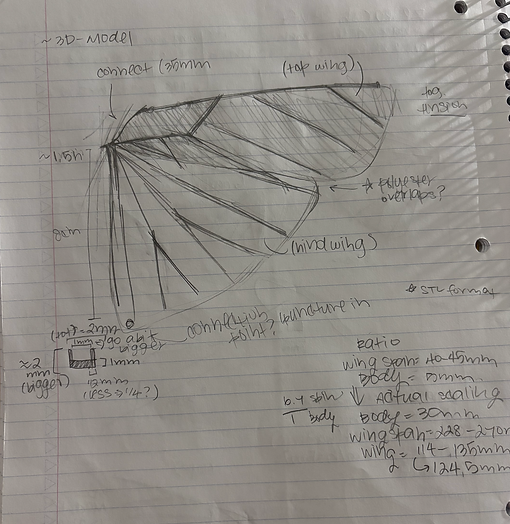

Blog Post II ~ Data Collection
My research goal is to try and mimic the flight patterns of an army cutworm using mechanical systems. I'll be using physics, engineering, and biology in order to determine if current technology has the potential to achieve the efficiency and capabilities of biological systems. I hope to develop an MAV that has similar flight patterns, power, lift, and potential as the army cutworm does.
Progress


3D Modeled Component of vein structure using Blender
MetaFly by BionicBird used as a base for drone
Through January to February of 2025, I've been focusing on design and data collection. I started analyzing the army cutworm by measuring its wingspan and body and studying its vein structure of its wing, which was the base of my design.
Simultaneously, I also ordered the base of my machine. After some research, I selected a flapping vehicle drone by BionicBird who also develops their designs using biomimicry. This drone is remote controlled, light in terms of mass, tolerant to damage, and can be easily assembled and disassembled. When the drone arrived, I measured its body and planned the size of my designed wingspan to match the ratio of the army cutworm's wing versus body.
Using Blender, a free modeling software, I was able to 3D model my prototype. I used the data previously mentioned from both drone and moth to design the vein structure with respects to the scaled sizes and lengths. The modeling software runs very smoothly and I was able to figure out all the mechanics despite it being my first time using this specific program.
Currently, I'm still working on modeling my designs, though I'm hoping to enter the final stage of my drafts soon. I'm looking forward to printing my completed design and assembling my drone!
Challenges & Problem-Solving
Throughout this process, I've run into many problems that were not outlined in the preliminary research I read. Specifically, I had some trouble with scaling, print material, and the 3D modeling softwares.
While some studies briefly mentioned the difficulty scaling, I didn't realize it'd be a huge issue until I started modeling. In order to achieve an accurate flight power and capabilities, the wings must be a certain size in comparison to the body. This means that my designed wings has to be a specific size that correlate to the ratio of an army cutworm's actually wing to body ratio. Additionally, I also had to account for the moth's mass when selecting my body and designing the wings. Some extra research was needed to account for this which ultimately took away some of my time for data collection.
Originally, I also thought that I would need two different printing filaments in order to achieve my design. The first would've been a regular filament to create the vein structure, but the other would've needed to be flexible and light, like the material moth wings are made out of. I was unable to conduct this because I would've needed to chemically bond the two prints which I don't have the materials nor expertise for. However, this problem was solved when I found that I could replace the second filament with a ripstop polyester, a cloth that is used to make kites.
Finally, while Blender was relatively easy to use, I still had to take some time learning the different controls and mechanics. In the past, I'd only used AutoDesk which needed a subscription. Blender operated similarly, but there were still many things that I was unfamiliar with. I spent some time with tutorials and videos in order to familiarize myself with Blender which took some time away from data collection and design but ultimately benefitted me in the long run.
Data Highlights
As previously stated, many calculations were done in order to determine what my wing design should look like. Some of these numbers included its dimensions, size, and mass of the wing. I also considered the potential power and velocity that the BionicBird is supposedly able to exert.
According to its producer, the body will have a power of 1.6 watts and a velocity of 5 meters per second. The mass comes out to be about 10 grams with the wings, meaning the supposed work the drone can exert is 0.125 Joules in an environment where air resistance is negligible.
The body of the army cutworm is 5 millimeters and has a wingspan of 40-45 millimeters. After scaling, my design is planned have a wingspan of 228-270 millimeters with each wing being 124.5 millimeters. The height will be 90 millimeters with the hindwing being 80 millimeters while the front wing is 10 millimeters. All these numbers are essential to accurately mimicking the flight capabilities of the army cutworm.

Blueprint of final design + measurements of scaling and dimension